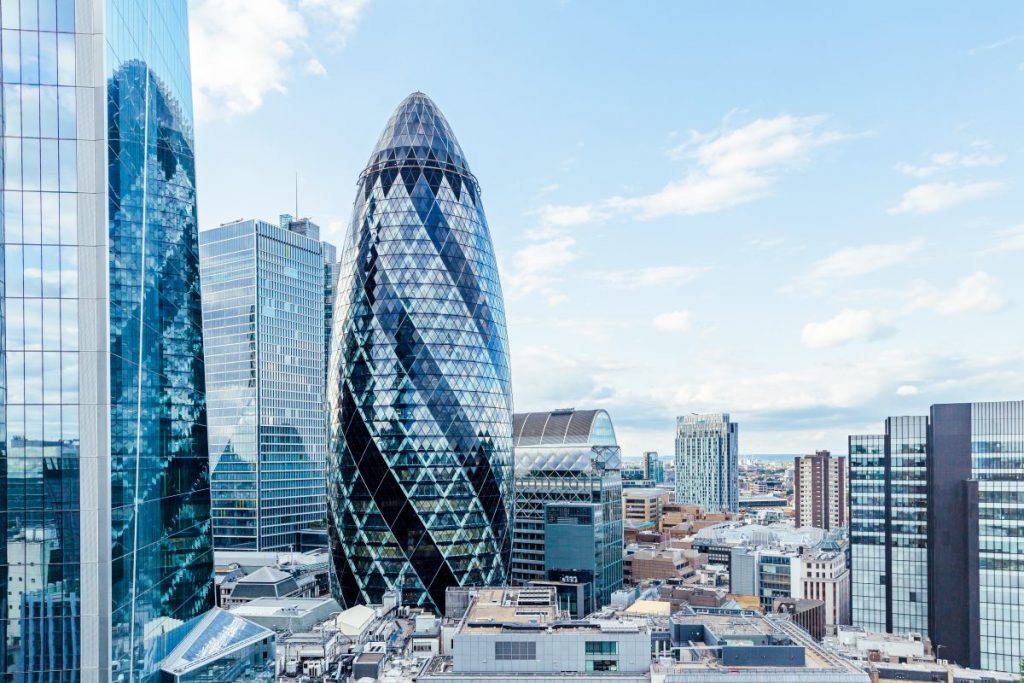
Quarterly Outlook: Sustainomics and a world without QE
Quarterly Outlook: Sustainomics and a world without QE
Chapter 1: Sustainomics: The Economics and Investment implications of the Sustainability Theme
Throughout history, the United Kingdom has paved the road towards the liberal state. In 1688, England defined the modern concept of parliamentarism. Soon after, Adam Smith’s principles linked commerce and freedom, inspiring the current three-century-old economic model. In the 1980s, the model was reasserted and emancipation from the state moved even further. Despite the demise of the British Empire, the paradigm of the British liberal state lives very much in the spirit of modern American Capitalism. Progress, for Britain, often equals less state.
For the modern historian, then, it must be somewhat of a conundrum that last Autumn’s budget, coming from one of the most comfortable conservative majorities in recent memory, featured more Big State, not less.
When this pandemic started and governments stepped in to save companies hit by lockdowns, we argued that the future would see an augmented role of the state in western liberal economies. Our commentary focused on the government’s role in directing industry towards desirable goals. This made sense. The non-financial corporate sector has the heftiest debt load except governments themselves and could not be given a blank check with public money.
The British budget revealed another dimension of state intervention. Fiscal spending fuelled by higher taxes. The level of institutional support during the pandemic will require expansive tax strategies to refill state coffers. The damage done to the beleaguered education system and the NHS is significant.
During the last crisis, twelve years ago, governments avoided fiscal interventions and instead let central banks and quantitative easing do the heavy lifting. As a result, the financial economy grew exponentially while the high street economy stagnated. And where the latter grew, it did so in the direction of tech products. Consequently, the eight first companies in the S&P 500 belong to the tech sector and account for more than a quarter of the world’s leading equity index. Clearly, what little growth western economies experienced, was neither equitable nor in any way balanced.
Classical economics assumes that aggregate consumer spending will always lead to the wisest economic decisions. But decades of rapid growth have led to the depletion of natural resources to the point where the human species is adversely terraforming its own home. As debts pile for future generations and the air becomes thicker, the prevailing thinking amongst political leaders is that too much is at stake to let consumer randomness decide the next steps of economic development. Writing checks indiscriminately could, potentially, boost consumption, but it would take a long time for free market enterprise to repair infrastructure or create the conditions for the country to thrive in a post-Brexit environment. Despite the ruling party’s underlying ideology, Big State, already a decade present in financial markets, was long bound to make an appearance in the real economy. With it, higher taxation.
The Era of Sustainability
The fact that the budget came from a Conservative party may look surprising, but it demonstrates how pragmatism and need can easily trample and possibly redefine ideology. While its provisions were related to the pandemic, we have every reason to believe that the coming era of Sustainable Economics, ‘Sustainomics’, may well feature an even bigger state and, consequently, more consumer dis-empowerment.
The biggest undertaking in recent human history, is probably climate change. Global leaders seem serious about reducing carbon emissions and keeping global warming levels near their present levels. If successful, the endeavour would arguably dwarf most other achievements in history.
During COP26, the UN’s 26th climate conference, more than 130 countries have pledged to end deforestation. More than 40 countries agreed to phase out coal on the next few decades. Over 100 countries agreed to reduce methane emissions. And more than 137 countries have committed to net zero emissions, most by 2050-2060[1].
It’s not just countries. Companies are increasingly called to prove that their footprint will not only harm the planet, but also the social ecosystem around them. ESG (Environment, Social, Governance) is now a major requirement for many corporates. In the UK, changes to the Companies Act of 2006 make it mandatory for larger companies to report on non-financial matters, including stakeholder engagement, a key component of sustainability reporting[2]. The EU has also adopted prudential and conduct-based directives on ESG[3]. The movement is gaining global acceptance. In November 2021 the IFRS Foundation, the global financial reporting standard-setter, announced[4] the creation of International Sustainability Standards Board (ISSB) ‘that will develop a comprehensive global baseline of high-quality sustainability disclosure standards to meet investors’ information needs’.
Sustainability is a major investment, regulatory and political theme. In the past, the Environmental-Legal-Regulatory-Political risk factors were bundled in organisations’ annual reports. However, the sheer burden transformation obligations undertaken by nations after COP26 will tend to subdue legal, regulatory and even political concerns under the great umbrella of Sustainability. For the uninitiated, that notion encompasses far more than ‘Environmental’ concerns. At its core lies a complete overhaul of how we think of business, politics, and the human race’s relationship not just with the planet but also with each other. It commits those entities, participating, be it governments, businesses or supra-national organisations, to a total change of course and thought. Investor vigilance is heightened and failure to espouse the core of those values could result in financial oblivion, not to mention social ostracism. It would be no exaggeration to say that humanity has never so voluntarily and entirely undertaken the road to self-improvement.
As we enter the era of ‘sustainable’ economics, we will have to come to terms with a considerably bigger state and, at least for a decade, possibly higher inflation. Post-pandemic pressing realities may be just the start. In the next few years, the western consumer may not nearly be as empowered as in the previous decades, if the world economy is to be set on a more sustainable path.
But, besides the return of Big State and the overhaul of economic liberalism what does Sustainability mean from a portfolio and economic perspective?
Economy
The economics of Sustainability breaks with some of the classical tenets of Capitalism. At its core, it does not accept that the decisions of consumers maximise long term happiness for the whole. Nor does it embrace eastern Confucianism, where the individual is merely subject to the whole. In essence, it’s a bridge between western and eastern governance philosophies. A transition from Adam Smith to John Nash, whose famous ‘Nash Equilibrium’[5] suggests that a utility is maximised by considering not just what is good for the individual, but what is good for the individual and the whole at the same time.
Covid-19 vaccination programmes are an excellent illustration of the problem. Vaccines are produced with the funding of developed economies. As a result, citizens of those economies have the right to be vaccinated first. This makes sense. However, what happens to surplus production? Western countries have opted to build inventories and focus on convincing the holdouts within their society. At the same time, however, vaccines are not sufficient for developing countries, which account for 6/7ths of the global population. As a result, new variants spring up which may, eventually, render western vaccination problems useless. The Omicron variant has already turned a two-vaccine plan into a three-vaccine plan. At the time of writing, Israel is offering a fourth dose within a year. But as the developing world remains in want, the possibility of even more aggressive and vaccine-resistant variants increases.
In a crisis, it makes sense to fall back to protect one’s own. However, in a globalised world, borders become more theoretical than practical. As such, problems ‘at the other end of the world’ find a way of impacting even the most developed nations.
It’s not just the environment. The problem is manifold. The United Nations have identified no less than 17 sustainable development goals[6]. All of these suffer serious setbacks due to the pandemic. Some of the most pronounced are:
- Global poverty. 7% of global population is expected to live in extreme poverty for the next decade. The pandemic has exacerbated the trend, as 150 million people, half the population of the US, were pushed back into extreme poverty in 2020. Political instability is a direct result of poverty.
- Zero Hunger. 6.7% of children under 5 suffer from malnutrition. Overall, 2.37 billion people are without food or unable to eat a healthy balanced diet. Mass migrations are often the result of poor living conditions.
- Good health. Covid-19 threatens to reverse a decade of progress in reproductive, maternal and child health. The pandemic has shortened life expectancies across the globe and 90% of all countries are reporting one or more disruptions to essential health services.
- Quality Education. Participation in organised pre-primary learning increased from 65% in 2010 to 73% in 2019. However, the pandemic has wiped out 20 years of education gains.
- Gender equality. Women are under-represented in national parliaments (25%), local governments (36%), and managerial positions (28%). Meanwhile, studies suggest an increase in violence against women after the onset of the pandemic. The pandemic, further, is adding to the buden of unpaid domestic and care work and squeezing women out of the labour force. Women spend 2.5 times as many hours as men on unpaid domestic work. This has resulted in lower labour participation rates in developed countries, wage inflation and, up to a point, is responsible for more hawkish central bank policies.
- Clean water and sanitation. 2 billion people lack safe drinking water and nearly half of the world’s population lacks basic sanitation and hygiene. Meanwhile, natural wetlands shrunk 35% in the last 50 years, and the rate of forest loss tripled. The effects on climate and carbon emissions are significant.
The UN’s other goals are affordable and clean energy, decent work and economic growth, industry-innovation-infrastructure, reduction of inequalities, the development of sustainable cities and communities, responsible consumption and production, climate action, preservation of life in the oceans and on land, strong institutions and the development of global partnerships.
At the time of writing, global fossil fuel subsidies exceeded $5tn, over 6.5% of global GDP[7]. The winter of 2021 will probably see a significant expansion of those subsidies, as pandemic disruptions have caused energy prices to soar. It will take decades to lower those subsidies and turn them towards renewables. Overall, the global decarbonisation cost could exceed $130 trillion by 2050[8]. This would be more than ten times the cost of the pandemic (so far) and 1.5x global annual GDP. Carbonisation is just the more pronounced and profound goal
Our view
We believe that Sustainomics are a case of undeniable long term benefits, which come with high and not necessarily quantifiable short term costs. However, businesses and investors must heed caution. Long term benefits are more about making sure growth is ‘sustainable’ than they are about seeking growth at all costs. This is a major departure from past trends. In history, ‘breakpoints’ are single points in a cycle that completely change its dynamic. If they are positive in nature, like a technological breakthrough, growth rates pick up significantly. After the introduction of steel in construction, railways, steam and the internal combustion engine, the US went from the destruction of the civil war to becoming a global economic powerhouse. Or the evenets might be negative in nature, starting a destructive process which forces policy makers and businesses to rethink their models and then leading ti high growth rates. Traditionally, war has been the starting point for many social and economic re-inventions [9]. The German and Japanese economies became economic powerhouses after the Second World War, along with the US. Before them, the British Empire’s economic prowess was founded not just on expansion wars, but also on consolidation of power in the European continent. Pandemics can be pivotal points too. In the fourteenth century, the ‘Black Death’ killed nearly a third of the European population. As a result, the medieval feudalism system broke down, power was passed centrally to the kings and the Renaissance ensued.
This time around, we are dealing with an event that hasn’t happened yet, and whose urgency is still a matter of political friction and debate. Climate change is real, but it has yet to significantly disrupt the lives and economies of developed nations. So provisions will be made for consumers/voters to avoind as much of the short term pain as possible. In other words, the future nature of the emergency makes change slower. As a result, we don’t expect to see the kind of ‘creative disruption’ reserved for history’s pivotal points.
Sustainability is about turning a generation of ‘consumers’ into a generation of ‘caretakers’. It is also about forcing money into research that will, in all urgency and haste, replace traditional power sources with new and cleaner ones.
We believe that the ‘Era of Sustainability can be divided into two different periods. A medium-term five to ten years ‘Phase one’, where we transition away from fossil fuels and a ‘winner takes all’ economic model, to a cleaner environment and more ‘equitable’ growth. This will be the phase of ‘growing pains’, mistakes and politics. The long-term dividends will be out of reach. In ‘Phase two’ these goals will -hopefully- have been attained. Growth will have been restored and upheaval will have subsided.
In the very broadest terms, this is the economic environment we expect in the next few years to look like, all other things being equal, from a sustainability perspective.
Phase one 2023-2030/35
Slower growth, more state, sector rotation: In this period, we expect overall global growth rates to slow down. The period will feature intense sector restructuring as companies compete to position themselves in this new environment. The bulk of the growth will come from the private sector, but growth itself will be much more regulated and directed by the government and paid for by higher taxes.
This would translate into incentives for companies who espouse an ESG philosophy and can produce proof of that and high costs for industries and firms left behind. Overall, growth rates should drop versus the previous 2.0%-3.0% rate, maybe by half a percentage point on average. Sectors like infrastructure should be at the forefront of this global transformation. Meanwhile, the Energy sector will need to redefine itself, away from fossil fuel subsidies. Manufacturing, as a whole will also be affected. From zero-carbon footprints, to labour relations to automation, industrial production will go through immense changes across the globe. Take for example the, strategically important, technology sector. Semiconductors will have to reduce the usage of water and electricity. Sustainability will also mean more ethically sourced materials and assembly. Automation will probably replace cheap labour in many places in the world. But an automated plant will have fewer incentives to be off-shore, so developed markets should experience a modicum of re-shoring. Meanwhile, where production is left in Asia, labour relations will have to be redefined to address the “Social Impact” factor. Taken further, the role of Asia as the world’s manufacturer will be challenged under an ESG framework. The re-definition of labour relations should also significantly affect services, especially the parts which are outsourced. We expect most sectors to experience changes and rotations in leadership. This should result in medium-term increases of output gaps (the capability of production less actual production), both at a macroeconomic and at a microeconomic level. However, we expect a pick up from peripheral demand over the medium term.
Higher Inflation, less central banks: In the past twenty years, developed economies experienced very modest inflation. This was the confluence of slower demand (as purchasing capabilities were transferred to emerging market consumers) and cheaper supply of goods, as many assembly lines moved to countries with lower salaries. Automation and ethical sourcing will redefine labour relations, especially with developing nations. Meanwhile, the restructuring of the manufacturing sector should put medium-term pressure on supply chains. All of these developments are inflationary in nature. The ‘ESG’ framework as a model for global corporations will present medium-long term supply pressures on prices. Demand price pressures should also emerge, not from developed but the developing market consumers. This means that central banks will have to pass the growth baton back to governments, as they will be restrained by debt limits and inflationary pressures.
Risks
Any ten-year outlook comes with caveats. There are significant risks to it, both on the downside and on the upside.
Upside Risks: A new energy source: The main upside risk comes from the development of new technology. Governments will direct much money into developing alternatives to fossil fuels. In 1820, Nantucket Island was the energy hub of the world, as the centre of the global whaling industry. 40 years later, when steam and then gasoline were becoming more prominent, the island was virtually bankrupt. Just as the internal combustion engine changed the world around the turn of the twentieth century, a new energy technology could lead economic growth and development into new and completely unexplored paths. Take for example promising fusion technologies. Recent developments suggest that a technology that has been ‘thirty years away’ (and by some, it will remain so), is within reach [10]. The implications of using a few gallons of water to light a city for days are too immense to consider. ‘Green Hydrogen is also a very promising new kind of technology. Lithium batteries are already in use that could potentially store larger amounts of energy for commercial use.
Downside Risks: The main downside risk comes from the fact that climate change is an assumed rather than a de-facto risk. This leaves room for political interpretation, especially as higher taxes and higher inflation are involved. In many nations with heavy carbon footprints, the exchange of growth for a sustainable future is not viewed favourably by all parties. Changes in government could derail climate and general ESG commitments in favour of short term growth. Apart from politics, the risk of ‘scientific failures’ is also very real. The planetary ecosystem is a very complex algorithm to solve. Science is usually reactive rather than proactive. Our current models tell us that we may just stave off the worst effect of global warming if the planet gets only 1.5 degrees Celsius hotter. But what if this model is wrong by half a degree, and our best efforts don’t work? Or what if climate change is accelerated by currently unforeseen factors? The point here is that very expensive and long-term policy decisions are being made on less than exact scientific data. Should calculations or events prove them wrong, it could significantly undermine the sustainability theme.
This links to the other major risk. The ESG theme is heavily dominated by ‘E’, the environment. Environmental failures, or, conversely, the discovery of a new technology that could quickly de-escalate global warming, could have a significant impact on the other two pillars, ‘S’ (social) and ‘G’(governance).
Phase two
For phase two, beyond 2033, our view is much more brief, as visibility is virtually non-existent. Overall, we expect output gaps to close. Technology developed should restore growth rates to at least the previous 2%-3%. However, that growth would be even more skewed towards emerging markets than today, as labour contracts improve and EM consumers become more empowered, even outside China. Overall, demand growth should look different from the American-European centric model of today. Supply-side inflationary pressures should have abated, as new ways to optimise value chains will have been developed.
Some friction should remain. The dilemma between on-shoring and off-shoring will become more pronounced for western manufacturers, as labour costs in developing countries are set to increase, and brand risks from exposure to non-sustainable labour practices will be even more pronounced. Having said that, more equitable growth will also mean that developing countries with more empowered consumers will also be less dependent on foreign flows and investments.
In this environment, inflation levels should remain above the previous decade’s 1%-1.5% average, as deflationary tailwinds from labour cost differentials between emerging and developed economies should no longer apply.
Portfolios for the new environment
Our investment approach has a 3-10 year horizon and mostly applies to ‘Phase One’ of the Sustainability economy. It also mostly applies to listed securities. Although we believe that there are plenty of opportunities to make above-market rates of return in start-ups or other unlisted firms, our focus remains on liquid securities, especially in an environment that will feature less Quantitative Easing than in the past.
Investors no longer penalised
‘Green’ investing has been around at least since 2005. It was set back during the global financial crisis, and only re-emerged in recent years as part of the wider ‘ESG’ theme. However, until recently, fund managers that we interviewed acknowledged that ESG represented a limited opportunity set and investing in it could produce reduced returns versus average.
In 2021 this was not the case. The MSCI World underperformed its ESG equivalent, the MSCI World ESG leaders, by 2.7%, delivering 18.7% as opposed to 21.4%.
Of course we have to acknowledge that the ESG version of the MSCI comes with slightly higher valuations, 21.39 forward P/E over 19.77 for the MSCI world.
The point is not so much the underperformance, but proof to investors that the opportunity cost of investing in securities with higher sustainability ratings is much lower than in the past. The next couple of years will determine whether the situation is reversing.
Certainly, when we look at companies with the highest ESG scores, we can also see some patterns emerging. In the S&P 500, the world’s leading equity indicator, companies at the top quintile (top 20%) of ESG scoring, consistently show better profitability, higher valuations and lower debt scores versus those in the bottom quintile.
As of December 2021, top ESG quintile companies saw 14% three-year earnings growth, as opposed to -33% for bottom quintile. This reflected also much better cash flow generation and almost triple operating margins (15% over 5%). Top quintile companies created value (1.65 Return on Inv. Capital over Cost of Capital), as opposed to bottom quintile companies which destroyed it (0.93 on the same metric). Investors paid higher prices for top quintile companies (7% higher P/E than average) as opposed to 4% lower than average valuations for bottom quintile companies. Meanwhile, top ESG quintile companies had lower debt burdens, 4.2x to equity as opposed to 5.5x for bottom quintile companies.
This is not to say that the correlation is necessarily direct proof that companies with an ESG strategy are already preferred by investors. In our view, maintaining a consistent and high-profile ESG strategy is probably a consequence of better overall governance, which affects all aspects of business.
Flows
Flows into ESG vehicles have significantly picked up the pace in 2021. According to Morningstar[11] from March to September 2021, global sustainable fund assets almost doubled, to $3.9tn. This was mainly driven by European flows[12] (JPM chart), a result of new disclosure rules in Europe, namely the EU Sustainable Finance Disclosure Regulation which was enacted in March. The European ‘Green New Deal’ is estimated at €600 Billion[13]. China’s latest five-year plan entails a similar spend of $400 Billion.
While overall the pace of inflows is secularly declining, due to the rising popularity of passive investment, the rate of inflows in ESG-related funds far outpaces the rate for the overall active fund universe.
Europe remains dominant, accounting for 77% of relevant inflows, as opposed to 11% for the US.
However, we believe that this presents a significant opportunity for investors as the world’s deeper market has still to catch up. The US market lags similar regulation, mostly due to political resistance in the past five years. Even after the change in the Presidency and Democratic dominance in all chambers of government, the passing of the ‘Build Back Better’ bill, a massive investment programme with significant provisions which would boost ESG-oriented companies, is still unable to make it through Congress. It’s ‘Green infrastructure’ provision constitutes a $555 investment[14]. We think that the next few months will be pivotal. Inflationary pressures and the ongoing pandemic could have a significant impact on the Democrats hold on Congress in the next Mid-term election, due to take place in Autumn 2022. The Republican party has traditionally been more recalcitrant when it came to environmental regulation and a Republican control of the country’s legislature would probably result in further procrastination in the adoption of relevant regulation. This leaves about a year during which the Democrats can either push provisions through Congress that can significantly change the ESG -and thus investment- landscape, or push them through weaker ‘Executive Order’ frameworks.
Proof that companies are rewarded by investors when the framework is robust is usually enough to turn the legislative wheels, whoever is in charge. The asset management industry is already re-branding a lot of its products to adapt to the trend.
Whatever the modus or government, we believe that eventually, the US will follow similar ESG regulations.
Bonds or equities?
At the time of writing, companies that wish to increase their funding prefer to do so with debt. This is a trend wider than ESG, reflecting low bond yields as a result of twelve years of financial repression, i.e. direct purchases of fixed income securities by central banks. Long-term yields remain very low by historical standards and all companies can improve their capital structure by increasing their financing through debt rather than equity.
For fixed income investors, there is an added bonus. Fixed income risk is not linear but parabolic. Simply put, bond investors care less about volatility than equity owners, but rather focus on the possibility of default, which can usually occur due to mismanagement. Strong ESG scoring, while not concrete evidence of strong corporate governance, is still an indicator. ESG requirements benefit bondholders by offering a more concise look into how a company operates. At risk of verbal hyperbole, it is the next step to the 2000-era framework of Sarbanes-Oxley, which has defined corporate governance ever since the collapse of Enron.
Apart from companies, we expect to see a pick up in the pace of issuance for state and municipal bond issuance. Countries or regions which adopt ESG rules may expect to see a rise in investments locally. Meanwhile, governments prepare to tackle socially important issues, like student debt, through the issuance of debt, usually backed by reliable assets.
Although a lot of ESG-related investment has been directed towards bonds, we think that equities will eventually have their fair share. High inflation and retraction of quantitative easing by the Federal Reserve make fixed income less attractive to investors at low yields. The probability of a re-rating event is drawing closer. Lower coupons over the past few years means higher ‘convexity’ -the relationship between price and the yield of a bond. A sharp rise in yields would mean an even sharper drop in bond prices. As risks increase, we feel that investors will require increasingly higher yields in 2022 and eventually we would see more equity issuance.
Pitfalls
Despite the prevalence of the ESG theme over the past few years, we have seen that ESG ratings, on which roughly 60% of the money is allocated, has still ways to go before it is reliable by investors.
A recent exposé by Bloomberg[15], suggests that Morgan Stanley Capital International’s (MSCI) scoring rewards companies that are not affected by the environment, as opposed to companies with a positive footprint. Also, it demonstrates that, at least in the US, a lot of ESG disclosure is voluntary.
Not entirely unrelated, a similar article by the Financial Times[16] suggests that a lot of the numbers presented by management are un-audited.
We think these considerations might be a novelty for private investors but are not lost on investment professionals. The fact that flows doubled in Europe after the EU passed a solid framework around reporting suggests that investors will follow legislation, not just management promises or indices made of metrics they are not entirely comfortable with. We tend to take a similar approach when looking into our own providers, seeking proof that underlying holdings are indeed vetted rather than passively adhering to metrics.
The three things for investors.
One: Sustainability is a juggernaut. With equities and bonds very expensive, after years of financial repression, Alpha for portfolios will come through the selection of themes, rather than just weighing asset classes and regions.
Sustainability is not just the theme of the year, but possibly of the decade. For the first time, humanity has made such a concerted effort to address environmental issues. Governments and private investors will increasingly require proof that a company is ‘doing good’, not just for ethical purposes but for fear that the cost of not participating in the Zeitgeist might be too big. There’s no substitute for the proverbial investment ‘bandwagon’. Meanwhile, demographics have changed and ‘values’ are much more important in consumer decisions than in the past. Consumers tend to ‘follow’ brands, rather than just purchase. But information is so fast and pervasive, that companies can ill-afford practices which could be condemned by their followers. Time and again we have seen significant brand impacts of even minor events.
The three biggest economic blocks (US, EU and China) have pledged over $1.62tnm our roughly 2% of annual global GDP just for Green energy initiatives. As the private sector participates more confidently, economic multipliers are set to be larger than 1x. Meanwhile, regulation is driving flows into the theme, rather than out of it, suggesting how important it is to ringfence sustainability. It is no exaggeration to say that the sheer amount of money institutionally directed towards ESG, not to mention the wall of regulations, are enough to render most other investment themes peripheral to the sustainability juggernaut.
Two: Things will be different when the US joins. American reluctance has held back a lot of institutional money that would have been directed to its market. However, US markets are by far the deepest in the world, backed by the global reserve currency, the Dollar. We think that 2021 will be a pivotal year, as companies will realise that there’s more to gain by ESG regulation than lose. This should significantly reduce pressures on lawmakers and, dare we say, even reverse pressures towards regulation, as American listed companies will want inflows similar to Europe. When -not if but when- the US joins them, we believe that returns, especially in the beginning, could be significant for investors of all classes.
Three: Trust your manager. ESG scoring is weak and we expect changes in the framework sooner rather than later. This means that, for the time being, active managers and good fund selectors have an edge on picking investments with a true ESG compass. Those companies will, in all probability, not lose investment support when ESG frameworks are updated. Conversely, passive ESG investing could suffer when companies that may have less robust frameworks are downgraded.
Chapter 2 Investing in a new regime
In a nutshell
Despite the sharp economic downturn in 2020, we have long maintained Covid-19 had barely interrupted the 12-year financial cycle. It could be argued that while the economy is embarking on a new cycle, the financial world was so decoupled, that it remained in the previous one. This new economic cycle, however, brought with it a previously unanticipated bout of inflation. Central banks, whose support for risk assets have underpinned investments since Lehman Brothers collapsed, are now more hawkish in a bid to prevent supply-side bottlenecks from transmuting into demand-side inflation. A year after the demise of the economic cycle, the twelve year financial cycle is now also consigned to history. What this will mean for portfolios, will be subject to a lot of scrutiny and revision.
The case
It may be difficult to remember, but in the midst of the global financial crisis and long after, Quantitative Easing (QE) wasn’t really trusted by markets. For the next five to seven years, almost until 2015, most money managers did not trust the bull market and remained underweight risk. They paid with underperformance and the rise of passives. Then, we began to wonder what could ever stop the QE juggernaut. The answer was always simple: inflation.
In the past few weeks, US inflation hit a 40-year record of 6.8%. The fine print says that the bulk of the price rises focuses on energy prices and cars/trucks. And also, that it is supply, not demand-driven, which means it would respond very differently to interest rate hikes. However, once a number like that hits the headlines, details are forgotten and things happen quickly.
In a very different modus operandi from the last pandemic resurgence, central banks are now on a firm tightening road, however their policies are diverging. Up to September, central banks were quite relaxed with inflation, as long as it was driven solely by supply factors. Despite their unease, as we said previously, they know that affecting the cost of money will have little effect on supply issues. However, evidence of wage inflation is strengthening caused an about-turn in strategy. In the US and the UK, where wage pressures are more pronounced, the Federal Reserve and the Bank of England are set to embark on a series of interest rate hikes. Financial markets are currently pricing in three hikes for each until the end of 2022. The Fed is also determined to stop quantitative easing by around March. In both cases, monetary tightening in the real economy is nominal and certainly not commensurate to 5%-plus inflation. It is a calculated bid to prevent supply-side inflation, which they can’t really control, from becoming demand-driven.
Conversely, in Europe and Japan, where labour laws are tighter, so far we haven’t seen significant evidence of wage pressures. As a result, the European Central Bank and the Bank of Japan continue on a much more accommodative path, at least for the time being.
The story of inflation
It is difficult to find a participant in today’s market who remembers what this kind of price pressure even feels like. Last time inflation was running this hot, the Cold War was raging, personal computers had not been invented, ‘Chariots of Fire’ was named the best movie of the year and Ben Cross was the hottest name in acting. Meanwhile, an unlikely Hollywood actor named Ronald Reagan had freshly occupied the White House. Interestingly enough, however, the present incumbent in the Oval Office, Joe Biden, was already a 10-year Senator from Delaware. His memory of how inflation brought down his party’s President, Jimmy Carter, should be vivid, as he sees his own approval ratings slide for the same reason.
In the last twelve years, monetary accommodation ballooned and central bank assets for the US and the EU rose nearly eight times. All they achieved was a meagre 1.5% inflation. Policy leaders fretted about deflation and tortured their intellects about how to normalise the yield curve again and turn money lending into a profitable operation once more. They talked rates up; they tried to stoke inflation expectations but to no avail. The yield curve remained flat as a pancake. It took a global pandemic and the biggest post-war supply chain shock to see inflation.
No longer ‘transitory’
On the face of it, then, it might sound wise and even timely that the Fed decided to drop ‘transitory’ from its vocabulary.
True wisdom, however, does not come from optimising predictions, especially after the event. As any person over a certain age knows, it comes from accepting what one can’t control.
Milton Friedman, the Nobel laureate economist and intellectual leader of neoclassical economics, famously proclaimed that ‘Inflation anywhere and everywhere is a monetary problem’. Remove excess money supply from the system and demand comes back down to meet supply, stabilising prices, the theory goes. This tenet has been the bedrock of central bank policies in the era of Monetarism (post-1971). On this aphorism, and Paul Volcker’s success as Fed chief in the 80s, central banks were given extraordinary powers and independence in order to fight inflation. Their basic tool? Interest rates. To reduce the excess supply of money, policymakers just had to make it more expensive.
The model may work well for demand-driven inflation. If cheap credit boosts demand, then expensive credit would suppress it. But what we are experiencing is not demand-driven inflation. Prices go up because supply chains are broken, creating a vicious circle where the uncertainty of delivery causes buyer behaviour to become erratic (ordering outside normal patterns), further destabilising supply chains and so on.
This is a phenomenon that central bankers have not had to deal with in the past. Oil supply disruptions in the 70’s are a poor analogy.
The last twenty years saw a persistent drop in prices, as a result of globalisation. The unspoken truth amongst policymakers is that supply chain optimisation, not central bank policies, kept prices in check. In other words, their basic mandate, inflation, has long been out of their control. Because it was going down, not up, no one bothered. Central bankers, instead, focused on maintaining financial stability by increasing banking oversight b and flooding financial systems with cash.
Let us not lose sight, then, of what central banks have evolved into by pretending they can still adhere to their inflation mandate. They transitioned their institution from ‘stewards of inflation’ to ‘risk enablers’ for financial markets. Central bankers should have learned that they have no control over prices, after a decade of ‘Japanisation’ of their economies, where they tried, and repeatedly failed to bring inflation up to 2%. Their attempts to lift the long part of the yield curve (to make money lending profitable again) and inflate away some of their countries’ soaring post-GFC debt simply did not work.
The pandemic hasn’t demonstrably changed trend demand conditions. Suppose somehow Covid-19 were to magically vanish tomorrow morning and global goods and services orders were to normalise instantly. Do we have any evidence that the economy would not be as ‘Japanised’ as it was in 2019, thus controlling prices as elusive to central banks?
So why are they even trying? Why is quantitative easing, which has proved to be completely unrelated to general price movements over a decade, now linked to inflation? Why are interest rates, a mechanism designed to control demand, being used to fight what is clearly a supply issue?
Who are central bankers trying to convince?
We think the answer is surprisingly simple: politics. To misquote Mr Friedman, ‘Inflation is everywhere and anywhere a political problem’. Inflation is a very visible ‘tax’ on consumer incomes. This causes incumbent governments to become unpopular, as Mr Biden recently found out. Elected leaders are ready to shoulder the political cost of taxes they impose, usually on a specific and targeted segment of the population. But inflation may wreak havoc across the board and seriously disrupt political planning.
Marc Bellmare is an economist at the University of Minnesota. His work shows that once price hikes hit supermarket shelves, the political environment can become toxic. Mr Bellmare found a strong link between food prices and protests, strikes and riots in many parts of the world between 1990 and 2011. His findings do not account for social media and hyper-partisanship, which may amplify the effects.
So far, price rises were focused on a small part of the economy, namely energy and used car prices (as manufacturers struggle to deliver new vehicles due to microchip shortages). Gasoline and heating prices went up for some consumers (many are still on fixed or capped heating bill rates), but overall prices in the supermarkets remained under control. This has begun to change. Food inflation in the US is now 5.6% per annum. In the UK it remains controllable, 1.3% and so in the EU, 2.3%. But it has been on the rise.
This puts the onus on central banks to demonstrate that they can control inflation and that their sole job is not to prop up asset prices. Likely, central bankers aren’t blind to the limits of their powers. Still, they are responding to inflation with more hawkishness to reassure both the public and their political superiors that they are in control.
It’s not just the US. Or the UK, where the newly installed Bank of England leadership has shown indecision regarding interest rates. Some countries, like Germany, are more sensitive to inflation than others. German CPI at 6% is now at the 95% percentile (top 5%) since the country’s post-reconstruction in the 1950s. German consumers are already disgruntled over negative bank rates for over five years and ignoring inflation is politically prohibitive, especially for a fragile and diverse new coalition government. So while the German government and central bank transitions have allowed ECB’s Christine Lagarde to maintain a very dovish stance, it stands to reason that they will quickly challenge her, if the country’s mainstream media are any indicator.
Inflation might not necessarily always be a monetary problem. It is, however, always and everywhere a political one.
Since 2008, the US central bank has exercised a dominating amount of control over the prices of all assets across the risk spectrum. It was not just its ability to throw trillions into financial markets at the push of a button. It was the threat that this posed to short-sellers. No one wanted to be caught with short positions at any time when the US central bank would decide to start printing. So, they were long.
The Fed’s freedom to print money at will, in all probability, shall be soon tested. And with it, the cornerstone of the last twelve year’s financial paradigm.
For one, with inflation that high and wage pressures exacerbating and eating into corporate margins, the Fed’s compulsion to raise interest rates, i.e. make money more expensive, is growing. QE, which in essence makes money cheaper, can’t really exist in a rate hike cycle. Next year will feature a more hawkish Fed, so these sorts of decisions will be made easier.
To be sure, raising interest rates and stopping QE has more of a psychological effect than a real one. Inflation, not rates influence consumer behaviour. Rates are a signal that ‘we are doing something about it’. The signal is politically expedient and might serve the purposes of policy makers across all branches of government, especially during a mid-term election year for the US. But raising the cost of money in the US by a fraction does very little to speed up the production and transferring of goods from Asia. Demand driving orders is not the result of credit-induced exuberance but rather panic, as wholesalers and retailers are running short on everything as a new Covid-19 variant becomes dominant. So, in all probability, no matter what the Fed does, this bout of supply-side inflation will remain firmly outside its control.
Hawkishness, even at the face of worsening economic conditions due to the Omicron variant, is more about signalling that substance. The plain fact is that with so much debt, governments simply can’t afford much higher rates on refinancing costs. However, even marginally higher rates should, in theory, dampen inflation expectations and stave off a wave of wage increases that could lead to an inflationary vicious circle. It is no surprise that the ECB, which has seen little evidence of wage inflation, is more dovish than its Anglo-Saxon counterparts. Futures markets now estimate three rate hikes for the US and the UK in the next twelve months, up from nearly one they expected last September.
A twelve-year investment paradigm, where the slightest market volatility would be met with the full force of the Fed’s printing machine, is clearly shifting. From ‘QE-on-demand’, financial markets are transitioning into a different regime, driven by a mountain of ‘residual liquidity’, which should take a long time to be absorbed into the system, coupled with the assumption that the ‘Fed Put’ will still hold in times of stress.
It’s difficult to imagine a regime change, however, no matter how well-communicated, without any sort of volatility. Investors still believe that the Fed is fundamentally dovish, which means they expect QE if equity indices drop below certain levels. The more the Fed stays its hand, the more nervous they will get trying to discover the ‘Put’s floor’.
We would not be too surprised if, in the near future, markets wish to test what the new limits are for the Fed to exercise its ‘Put’. We believe that, for 2022, investors should at the very least be prepared for more volatility. Gauging how the Fed responds to that will tell us a lot more about the terms and conditions surrounding the new investment regime.
What does this mean for investors?
In the investment committee, we fully assessed the rise of risks against valuations and market momentum. The Fed’s ability and willingness to suppress any sort of equity and bond market risk in the last twelve years is, at the very least, compromised by surging inflation. However, we don’t believe there’s sufficient reason to panic.
For one, there’s still plenty of money in the system. Since September 2019, the Fed’s balance sheet went from $3.7tr (already considered a huge balance sheet), to $8.6tn. A 130% rise in two years, which added another $4.9tn to the global financial system. More than $10tn have been added by the four major central banks (US, EU, China and Japan). For investors, that huge liquidity pool constitutes the most potent financial safety net in history. It will take years for that money to be fully integrated into the financial system. Fiscal stimulus in the US and China ensure more money for the real economy. So does the almost $2tn in Private Equity dry powder.
And, overall, money will remain cheap. Raising interest rates 1% or so, sends the message but does not make money materially more expensive. If central banks really believed that this sort of inflation could be fought with higher rates, then we would already be experiencing a 7% interest rate. With global Debt-to-GDP skyrocketing to 356% over the past two years, government debt-to-GDP over 110% for many developed markets, and fiscal easing on the way, materially raising the cost of capital is simply not an option.
But what about QE?
We have to accept that QE’s use was also, mostly, psychological. Short term market operations might still be used to bail markets out of trouble. But with inflation running that high, adding trillions of long-term money into the system within the space of months at first whiff of market distress, is probably out of the question, even if it’s just for politics.
Having said that, the pandemic is expected to dictate economic conditions well into 2022, but as far as financial markets are concerned the main risk is how central banks will react to it. Central bankers are pressured by rising and persistent inflation and are keen to reassert their role as independent agencies focused on ensuring price stability. Asset prices will have to take the back seat for now.
But we don’t believe QE is entirely dead. US households have a record 42% allocation of their total assets in equities. The political stakes of rising inflation are just as important as those of stock market stability. We believe that, at certain volatility the scales might well tip back against price stability and in favour of market stability.
Our base-case scenario remains that a sharp market downturn should reaffirm the ‘Fed put’, the promise that the world’s de facto central bank will unequivocally add to asset purchases whenever risk levels rise beyond comfort.
Should investors be worried?
Equity investors should get used to more volatility, and may well experience an equity re-rating and lower valuations in the next few months. This is more so for funds heavily exposed in tech, where valuations have risen disproportionately to the rest of the market. Focusing on fundamentals and being selective about managers will go a long way into preserving wealth.
Bond investors will have a more difficult time. High liquidity gives hope to traders that they might still find someone to take their holdings out of their hands at an even higher price. But the bulk of fixed income investors, who tend to hold the asset to maturity, is in trouble. Either they will lose a steady stream of money in real terms over the next few years, or they will experience a sharp correction in prices. Real returns (yield minus inflation) are deep into negative territory. Assuming 3% average inflation over the next five years, an investor in the five-year US Treasury note yielding 1.27% would experience an assured loss of 1.75% per annum, or 8.5% of their overall investment. Because no market can operate under an assured loss assumption, the probability for a sharp price correction (so that annual yields may rise) is climbing fast. Central banks will still remain a big buyer of debt, but adding no new money into the system would allow yields to drift upwards. We are already deeply underweight bonds and considering ways to mitigate the impact of a possible re-rating event on those that we do hold.
Why the case for remaining invested still stands
The end of QE and the end of the current paradigm, however, is not a disaster. The money already printed is not going anywhere and it can continue to fuel markets for a long time. And QE’s withdrawal will be handled with care. Inflation may be catastrophic in an election year, but so is a market rout, with US households having a record 41% of their total assets in equities. It may even prove a blessing in disguise, as it could return long-gone sanity to investment markets. To be sure, a post-QE and post-rerating world, is a different, more volatile, world. Volatility may be uncomfortable, but it is the mother of opportunity. Investors will see traditional strategies, like the 60/40 equity/bond portfolio, working again. Overall, this should reduce risks, or at the very least, make them more manageable. Shorting markets may, on occasion, pay off as a strategy. Shorting capitalism over the longer term, never does. And while we expect a tantrum, or more than one, we believe financial markets will outgrow QE, much like humans do: by learning, sometimes the hard way, that even if things occasionally go south, is not the end of the world.
What it means for portfolios
Central banks remain independent. That independence, which is politically granted, will undoubtedly come under scrutiny if inflation runs unchecked, for whatever reason. If we assume that recent, out-of-character movements from central banks are the product of political pressures, then independence has, de facto, already been somewhat compromised. With it, recent patterns for asset returns could change.
As for inflation? If interest rates aren’t the way to control it, we may have to learn to live with it, perhaps for a few years. Central banks will have to decide whether they are willing to let the mid and long-end yield of the curve adjust (which means 3-5 year rates over 3-4%) or face a permanent reality where the sole purpose of bonds as an asset class is capital appreciation because of institutional demand.
However, we now find that the probability of a cyclical or even secular hawkish shift of central bankers is not infinitesimal anymore. It is an observable and quantifiable scenario. As investors, we should at the very least be prepared and positioned for more market volatility and different patterns for assert returns as we are entering what is promising to be another exciting year.
Chapter 3: 2022 – The Outlook for the British and the Global Economy
2020 was a year of an- unprecedented in post-war times- global economic shock. Macroeconomic volatility far exceeded what we experienced during the Global Financial Crisis twelve years earlier. Developed market consumers were locked in their houses and demand fell off a very sharp cliff. Global value chains, for decades opting for efficiencies over inventory-build ups, went into an unexpected hiatus. Then, in early 2021, vaccination programs in developed nations resulted in a swift reopening of their economies. Demand surged, but supply chains were not ready to respond to it. 2021 was a year of a sharp but unbalanced and uneven economic recovery.
The first phase of the post-lockdown economic growth is over and we expect demand conditions to normalise. This should ease some pressure on global supply chains, but we still expect that thay will take a long time to mend. It is an open question as to whether they will return to their previous, lean structure in this decade.
We believe 2022 will be a year not ‘of recovery’ but rather a significant milestone, perhaps even the last one, on the road to a new sort of normality. It is worth noting that we held this view before the emergence of the ultra-transmissible ‘Omicron’ variant that is, at present, taking hold across the globe.
“Normality”, at this point, means some streamlining and predictability in global trade flows, which should echo along with other economic fundamentals. We think that the probability of a full return to some sort of “normality” before the end of 2022 at the earliest garners low probability. Supply chain problems are bound to persist as ports remain congested and transportation costs soar. Demand and supply are fluctuating wildly as companies continue to antagonise each other and raise prices to stock their inventories. Meanwhile, the Chinese slowdown, which is mainly a result of the Party’s attempt to reign in the growing power of businesses, should continue well into the following year. This was a strategic choice by Xi Jinping, not merely a knee-jerk reaction.
Meanwhile, labour markets are in disarray. Developed economies are seeing measurable reductions in labour participation rates, the number of those at employable age willing to even look for a job. Many stay at home, look for online jobs or opt to spend time with their families. Some are returning to University, a process that will take time to complete. The ‘Great Resignation’ in the West adds as much to economic pressures as its Chinese counterpart, the ‘Lie Flat’ movement, is affecting Asian economic output. Whether this is a reaction to economic inequalities laid bare after the ‘Great Lockdown’, or a fully-fledged counterculture movement akin to the late 60s remains to be seen. The fact is that with labour and skills scarce, wage pressures are adding to supply-induced cost pressures globally.
In 2022 we expect to see growth. Currently, projections suggest a 4.5%-4.9% expansion of global output. We also expect to see persistent inflationary pressures until at least the second half of the year. As long as developed countries don’t experience generalised lockdowns, however, we think that supply chains will gradually adapt.
Having said that, however, we think that, much like last year, risks are to the downside. Fiscal stimulus and the Chinese economic transition constututue long term drivers for global economic growth. But for the short term, the pandemic remains the key determinant of growth and inflation. It is also wildly unpredictable. The strategy of developed nations to favour domestic vaccination and a build-up of inventories will be good for demand but may exacerbate supply pressure and cause more mutations. It is no wonder that both the ‘Delta’ and ‘Omicron’ variants came from Africa, a region of 1.2b people where only 8.4% have received both doses of a vaccine. Early studies suggest that it will take three shots for vaccines to be effective against ‘Omicron’. This should push any vaccination effectiveness goals further into the future and risk the emergence of newer and even more aggressive variants.
Covid-19 has been picking up, but vaccination rates are rising, even in the Emerging Markets. New Merck and Pfizer medicines may quickly be added to the arsenal against the pandemic. We think the pandemic will end at some point in the foreseeable future. Even before the era of vaccines and antibiotics, ‘plagues’ eventually died down, usually as weaker strings of the virus became dominant and people built up antibodies.
We think that 2022 will be a volatile year in economic terms. The key term to remember is ‘uncertainty’. The breadth of scenarios is as wide as it has ever been. Small changes in key variables could severely alter the outlook.
In the pessimistic scenario, if Covid-19 persists and China maintains its regulatory offensive, growth is bound to slow down, even as prices remain elevated. The ‘Stagflation scenario’ (stagnation+inflation) could become all too real. Persistent supply chain issues, exacerbated by Brexit, are bound to have an impact on demand. Despite headlines, inflation is still manageable for most every day products, but this could change. Higher taxes will further pressure consumption. Meanwhile, higher rates, which would do little to fight imported inflation, will add to the woes of mortgage holders. Although nearly 80% of all mortgages are fixed, refinancing will surely take a toll, if not immediately then in the next 2-5 years. Rate uncertainty could make institutional investors more apprehensive for British and Sterling assets.
In the optimistic scenario, however, Covid recedes, and China takes a more paced approach to reign in businesses, gains in demand could be significant, despite tighter monetary and fiscal conditions for consumers. Return to work could take off wage pressures, benefitting businesses and reducing inflationary and concomitant interest rate pressures. Whatever mistakes made by the Bank of England will be quickly forgotten if growth picks up and inflation decelerates. Higher growth rates could deter the government from raising taxes, and may even prompt easing.
But Beyond 2022, the big question remains: Will we return to the world we knew in December 2019? In our view, the longer the pandemic lasts, the more likely is that some changes will become permanent. Changes may range from the mix and and participation of the labour force to the durability of supply chains, to the nature of white-collar work. Consumption patterns will almost certaintly be affected. As a result, we would not be too surprised if we see economic sectors restructure and rotate.
It is very early to say what the world will look like when this adventure is over. The main reason for that is that, unlike previous economic crises, this one was exogenous the the financial system. This means that the fix will not come from a policy, government or central bank driven. Different countries have responded differently. So did sectors and even regions within countries. The changes wrought will start local, and whatever super-trends emerge, they will not be centrally driven, but the average of miriads of bottom-up changes.
Economic perfomance in Q4
Global economic performance has picked up significantly in the past few months, both in terms of services and manufacturing. While the global economy remains well into expansionary territory, momentum is stalling as the Delta variant continues to advance and supply constraints may already be impacting demand.
Supply chain issues continue to plague the global economy, with transport rates and delivery times at all-time highs. Momentum is decelerating for both the manufacturing and the services sector. Due to weaker international demand, manufacturing demand has shown signs of abating, but capacity remains very tight as backlogs continue to increase. In the services sector, which accounts for a larger part of the economy, things are more diverse, with the US experiencing a sharp upturn and Europe slowing its expansion. Retail sales across the board are satisfactory, but the post-pandemic pent-up demand phase has passed. As a result of supply pressures, inflation is climbing at all levels. Employment conditions also remain tight, as developed markets have experienced lower participation rates (i.e. people have left the workforce altogether) and skill shortages persist, pushing wages higher. Inflationary pressures are having a positive effect on real estate prices, especially residential.
We have to note that inflation’s impact across nations and income cohorts varies significantly. Current inflation is mainly skewed towards energy and transportation costs. Lower incomes are bound to suffer more from higher gasoline, winter heating and car-related costs but less from food prices, which overall have risen less sharply. Accordingly, British people probably won’t be too surprised by prices at the supermarket, but they could be disincentivised to drive to work. Heating bills, however, will be a problem across the board as the winter arrives.
The US remains the world’s leading economy, both in terms of ouput and in progress towards normality. Economic conditions in the US remain firmly in expansion territory, with the region outperforming other developed markets. Having said that, momentum, especially in manufacturing, is gradually losing steam, despite strong new orders, as capacity and inventories remain challenged, supply delays are near-record and businesses are struggling with high costs, supplier and labour shortages. In the services sector, backlogs continued to rise fast, while a resurgence of Covid-19 weighed on new order growth. Consumer spending increased at a moderate pace and employment conditions improved, despite a November disappointment in payroll numbers. Still, childcare, retirements and Covid-19 continue to weigh on employment availability and push wages up.
Supply side pressures continue to have a significant impact on prices, with core consumption expenditure recording a 4.1% rise, the highest figure since 1991. Headline inflation hit 6.8% in November, the highest since 1982.
As a result of inflationary pressures, the Federal Reserve, whose Chairman, Jay Powell, was re-nominated to hold his post, adopted a more hawkish stance, especially in tapering asset purchases, causing some market volatility in early December.
The British Economy
The British economy remains on of the most open in the world. As a result it is deepy affected by trends in global trade. The disarray of global supply chains, thus, affects Britain more than its developed market counterparts. Overall, the British economy is rebounding and is on track to reach its pre-pandemic levels by June 2022, if we don’t see generalised lockdowns or a material economic impact from the Omicron variant. Roughly two and a half years of growth have been lost due to lockdowns, and projections suggest that output will run below its previous trajectory for at least two more years. December average projections suggest a 4.7% growth for the British economy in 2022, significantly below the OBR’s projection of 6%, which enabled a more expansive budget. CPI inflation for 2022 is expected to soar to around 5%, before it drops to 2.6% in 2023%. Meanwhile, unemployment is expected to remain steady, around 4.8%.
To maintain employment and put itself in a good starting position, the UK government borrowed heavily, brigning Debt-to-GDP from 85% in 2019 to 108% in 2021, projected by the IMF to grow to 111% by 2026. Deficits soared. For 2020 the budget deficit was 13%. For 2021 it is projected to be around 8%.
While the budget was less tight than originally anticipated, with overall fiscal spending increased by £150b, higher taxes burdening both employers and employees are set to dent consumption in the next year, at least until fiscal multipliers kick in. Spending is front-loaded, with the bulk of it in the next two years. In essence, the government takes upon itself to direct spending instead of leaving it to consumers, and it does so at the benefit of Health and Education, and possibly at the expense of Research. Government spending is set to stabilise at 42% of GDP, 2% above 2010-2015 levels. The budget comes on the heels of a hawkish turn by the Bank of England, which the market expects could result in three rate hikes by autumn 2022. Consumers are now faced with a ‘pinch move’, tighter policies on both the monetary and the fiscal fronts. Along with energy and other inflationary burdens, momentum for consumption could be interrupted.
We feel that the move to hike rates may be slightly premature. The UK would be hiking around six months ahead of the US and possibly a year ahead of the EU. Given that the bulk of inflation comes from external supply-side pressures, including labour supply shortages, rising interest rates would do little to curb it. Overall, consumption should be impacted adversely, albeilt marginally, because the impact on home owners will be spread out over a period of twelve to eighteen months. Overall, rates of 1% in and by themselves will not present a great challenge. But if one adds inflation and higher taxes, following the budget, we see higher rates as further exacerbating consumer sentiment and propensity to buy.
The question on everyone’s mind is whether this consumer tightening, monetary and tax, would bring the economy back to equilibrium, or whether it risks hamstringing a fragile recovery.
There is likely going to be a measureable impact on consumers, especially homeowners with a mortgage. The impact will be spread out, because 80% of all mortgages in the UK are fixed-rate. However, the bulk are refinanced every two to five years, so within the space of twelve months, possibly 35%-40% of mortgage holders will face the effect of higher rates. Lower consumption might have an impact on the top line (revenue) earnings of businesses, and could further supress margins.
Conversely, the banking sector, which borrows over the short term and lends over the longer term, should benefit from rising rates.
In terms of bigger investments on the UK, higher rates ahead of the rest of the world would put upward pressure on the Pound. Institutional investors could become more apprehensive and choose other markets where rates are more predictable, and currency will be lower. This could impact support for Sterling assets, stocks, bonds and cash holdings. Having said that, the impact will be marginal. We don’t believe international investors will give up on the UK after this. The country’s track record and G7-economy-status will probably redeem decision-makers in Threadneedle St.
On the one hand, consistent 15% deficits are simply not sustainable, no matter how much debt the central bank may absorb. At some point a return to some form of economic orthodoxy is warranted. Current projections brong the fiscal deficit down to 3.9% in 2022 and lower than 3% thereafter. On the other, decelerating global economic momentum, unprecedented supply chain constraints, Brexit and the course of the pandemic are already putting significant pressure on the British economy.
If global economic conditions normalise soon, then the Chancellor and the Government will be credited with a timely intervention to reduce debt burdens and directing spending wisely. If, however, raising taxes and reducing borrowing along with monetary tightening, prove premature, policy makers in Downing Street and Threadneedle Street could be forced to backtrack.
.
[1] Al Jazeera: https://www.aljazeera.com/news/2021/11/14/infographic-what-has-your-country-pledged-at-cop26
[2] Mazars.co.uk: https://www.mazars.co.uk/Home/Services/Sustainability-and-ESG/Reporting-compliance?
[3] EU Commission: https://ec.europa.eu/info/business-economy-euro/banking-and-finance/sustainable-finance_en
[4] Iasplus.com: https://www.iasplus.com/en/news/2021/11/issb
[5] Investopedia: https://www.investopedia.com/terms/n/nash-equilibrium.asp#:~:text=Nash%20equilibrium%20is%20a%20concept,deviate%20from%20the%20initial%20strategy.&text=Overall%2C%20an%20individual%20can%20receive,remain%20constant%20in%20their%20strategies
[6] IMF: https://www.imf.org/en/Topics/SDG
[7] IMF: https://www.imf.org/external/pubs/ft/fandd/2019/12/pdf/fd1219.pdf
[8] OECD: https://www.oecd-nea.org/jcms/pl_28600/the-costs-of-decarbonisation-system-costs-with-high-shares-of-nuclear-and-renewables
[9] War: The Great Leveler. Walter Scheidel. https://press.princeton.edu/books/paperback/9780691183251/the-great-leveler
[10] HBR: Nuclear Fusion’s Time is Finally Coming: https://hbr.org/podcast/2021/12/nuclear-fusions-time-is-finally-coming
[11] Morningstar Global Sustainable Fund Flows Report, https://www.morningstar.com/lp/global-esg-flows
[12] JP Morgan 2022 Long Term Capital Market Assumptions: https://am.jpmorgan.com/content/dam/jpm-am-aem/global/en/insights/portfolio-insights/ltcma/ltcma-full-report.pdf
[13] EU Commission: A European Green Deal,14 July 2021, https://ec.europa.eu/info/strategy/priorities-2019-2024/european-green-deal_en
[14] The White House, 28 Oct 2021, https://www.whitehouse.gov/briefing-room/statements-releases/2021/10/28/president-biden-announces-the-build-back-better-framework/
[15] Bloomberg, The ESG Mirage, 9 Dec 2021, https://www.bloomberg.com/graphics/2021-what-is-esg-investing-msci-ratings-focus-on-corporate-bottom-line/?sref=EiJDOcNb
[16] FT: Bogus Numbers Still Clound Company Accounts, Francine McKenna, 7 Decenber 2021, https://www.ft.com/content/a70ad7d5-2cb6-4d02-b43c-dacd2586d67f


















































